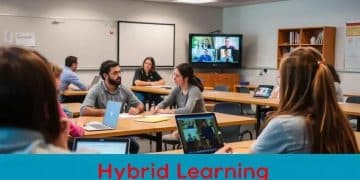Private sector funding for public school programs

Private sector funding for public school programs enhances educational resources, creates opportunities for student engagement, and can improve learning experiences while presenting challenges related to equity and sustainability.
Private sector funding for public school programs is becoming an increasingly important topic. Have you ever wondered how these funds impact education quality? In this article, we’ll delve into the dynamics of private funding in schools.
Understanding the role of private funding in schools
The concept of private funding in schools plays a crucial role in the education landscape today. Many schools depend on these funds to improve resources and enhance student experiences. But how does this funding really work?
Types of Private Funding
There are several forms of private funding that schools can tap into. Notable among these are:
- Corporate sponsorships that provide financial aid.
- Donations from alumni and local businesses.
- Grants offered by private foundations aimed at specific educational goals.
These resources can supplement public funding, leading to significant improvements in educational offerings. When schools receive financial support, they can invest in technology, extracurricular activities, and teacher training.
The Impact of Funding
Understanding the impact of private funding is vital as it often leads to:
- Enhanced educational programs that address student needs.
- Improved classroom resources and facilities.
- Increased opportunities for students through scholarships and internships.
This funding can create a diverse environment where students have access to a variety of programs, fostering a love for learning and personal growth. It’s essential to recognize that, while private sector funding can significantly benefit schools, it should complement, not replace, public funding.
Equity is another important consideration. Schools in more affluent areas may attract more funding compared to those in low-income neighborhoods. This disparity raises questions about the fairness of education access and quality across different regions.
In summary, understanding the role of private funding in schools helps uncover both opportunities and challenges. Schools can thrive by strategically leveraging these funds while ensuring they remain accessible for all students, regardless of their background.
Benefits of private sector support for education

The benefits of private sector support for education are numerous and impactful. When private organizations invest in schools, they enhance educational opportunities and resources for students. This support is vital in bridging gaps in public funding.
Improved Resources
One key benefit is the improvement of school resources. Private funding allows schools to:
- Purchase new technology for classrooms.
- Upgrade library facilities to include digital resources.
- Expand access to extracurricular activities.
With better resources, students are more engaged and can access a richer education.
Enhanced Learning Experiences
Another advantage of private support is the creation of enhanced learning experiences. Schools can offer more:
- Hands-on learning opportunities through workshops and field trips.
- Special programs tailored to student interests, such as STEM or arts.
- Scholarships that help students pursue higher education.
This focus on diverse educational experiences helps students build skills that are essential for their future careers.
Moreover, private sector support often encourages collaboration between businesses and schools. This partnership can lead to mentorships, internships, and job-shadowing opportunities that provide valuable real-world experience for students. By connecting students with professionals, they gain insights and networks that can shape their future.
Additionally, the presence of private funding may lead to innovative teaching methods. Schools often experiment with new curricula and best practices that arise from this financial support. The flexibility to try different approaches allows educators to find what works best for their students.
While challenges exist in balancing private contributions with public needs, the potential benefits of private sector support for education are clear. These funds can make a significant difference in the quality of education, providing students with opportunities they might not otherwise have.
Challenges of relying on private funding
While there are many advantages to private funding, the challenges of relying on private funding can significantly impact schools. Schools must navigate various hurdles when integrating these funds into their budgets and programs.
Equity Issues
One of the primary challenges is the potential for equity issues. Schools in wealthier areas may attract more private donations compared to those in underfunded neighborhoods. This disparity can create a divide in resources and opportunities for students, leading to significant differences in educational quality.
Accountability and Influence
Another concern is the issue of accountability and influence. When private organizations provide funding, they may expect to have some say in how those funds are used. This can lead to:
- Shifts in educational priorities that reflect the funders’ agendas.
- Pressure to implement programs that may not align with the school’s mission.
- Changes in curriculum that favor certain ideologies or practices.
This influence can create tensions between educators’ goals and funders’ expectations, which can complicate decision-making processes.
Additionally, schools may face challenges with sustainability. Private funding can be inconsistent, with grants or donations varying from year to year. Over-dependence on such funding can put a school at risk if those sources dry up. This unpredictability makes long-term planning difficult for both staff and students.
Furthermore, relying heavily on private funds can divert attention from advocating for necessary public funding. Schools might prioritize attracting donations instead of lobbying for increased resources from government sources. This shift can weaken the overall public education system.
In summary, while private funding can enhance educational experiences, navigating the challenges it presents is crucial. Schools should strive to find a balance that ensures all students receive quality education regardless of their financial background.
Successful examples of public-private partnerships

Successful examples of public-private partnerships showcase the potential for collaboration between schools and private entities. These partnerships can enhance educational opportunities and provide significant benefits for students and communities. Many school districts have embraced these partnerships to maximize resources and improve learning outcomes.
Case Study: Local Business Sponsorships
One effective model is local businesses sponsoring educational programs. For instance, a local technology company can partner with a school to provide:
- Workshops and training sessions for students interested in technology.
- Internship opportunities that give students real-world experience.
- Access to advanced tools and software to enhance learning.
This direct involvement allows students to gain relevant skills and encourages them to pursue careers in high-demand fields.
Grant Funding from Foundations
Another successful approach involves securing grant funding from private foundations. For example, a school district might work with a non-profit foundation to:
- Develop after-school programs that target academic improvement.
- Introduce STEM initiatives focusing on science and technology.
- Provide scholarships for students pursuing further education.
These initiatives can transform educational environments, offering students unique opportunities to excel.
Furthermore, successful partnerships often create mentorship programs where local professionals guide students through their academic and career paths. Mentorship not only aids in personal development but also builds networks that can support students in the future.
It’s also important to highlight examples where public entities collaborate with private companies to enhance school infrastructure. Upgraded facilities can lead to better learning environments, which are essential for student success. For instance, a partnership with a construction company can result in improvements like:
- Modernized classrooms equipped with the latest technology.
- Energy-efficient buildings that reduce long-term costs.
- Safe and engaging outdoor spaces for physical education.
These partnerships represent a win-win scenario, where private companies gain positive community recognition while schools receive valuable resources.
FAQ – Frequently Asked Questions about Private Sector Funding in Education
What are the benefits of private sector funding for public schools?
Private sector funding can improve resources, enhance learning experiences, and offer more opportunities for students, such as internships and scholarships.
How can public-private partnerships affect equity in education?
Public-private partnerships may lead to disparities, as wealthier areas can attract more funding, potentially widening gaps in educational quality.
What challenges come with relying on private funding for schools?
Challenges include issues of accountability where funders may influence school decisions, and the sustainability of funding which can vary year to year.
Can you provide examples of successful public-private partnerships in education?
Examples include local businesses sponsoring programs, grant funding from foundations for after-school initiatives, and infrastructure improvements through collaborations.





